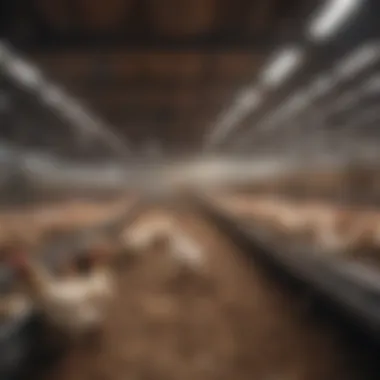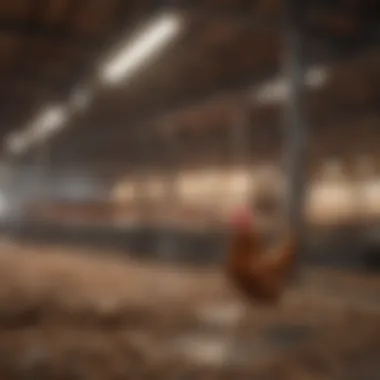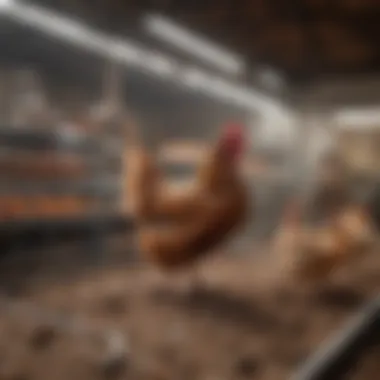Understanding Poultry Heating: Best Practices and Insights


Intro
Poultry heating is essential for the optimal growth and health of birds in various farming setups. A comprehensive understanding of heating methods can lead to better productivity and sustained poultry welfare. Knowing which heating system to choose can be complicated due to numerous factors in play, including environmental conditions and specific heating needs of different poultry breeds.
This article will guide you through the varied heating solutions available, from forced-air systems to radiant heaters, and traditional brooding methods. Each method has its own set of advantages and challenges, and selecting the right one is crucial. We will also delve into the importance of temperature management and offer practical tips that cater to both novice and experienced poultry keepers.
By exploring heating methods, best practices, and advanced techniques, readers will gain meaningful insights to enhance their poultry management practices.
Poultry Heating Methods
Forced-Air Systems
Forced-air systems are one of the most effective methods for heating poultry houses. These systems use fans to circulate hot air throughout the barn. This uniform distribution minimizes cold spots and ensures all birds experience consistent warmth. These systems can also control humidity levels, a critical factor in poultry welfare.
While effective, these systems require careful management. Adequate airflow must be maintained to avoid drafts, which can negatively affect bird health. Monitoring temperature accurately is crucial, and regular maintenance will keep it running efficiently.
Radiant Heaters
Radiant heaters, on the other hand, warm the area by directly heating surfaces instead of the air. These can be gas or electric. The heat radiates down to the birds, providing comfort while conserving energy. Radiant heaters are especially suitable for smaller poultry enclosures, as they allow for localized heating.
One must also consider the installation of these heaters. They need to be mounted at a safe height and distance from the birds to prevent overheating. Thus, installation requires careful consideration of barn layout and bird behavior.
Traditional Brooding Methods
Traditional brooding methods are commonly used for young chicks. These include heat lamps and heat mats that provide warmth in designated brooding areas. While these methods can be effective and cost-efficient, they often require constant supervision to ensure the temperature does not fluctuate dramatically.
Using heat lamps may not be ideal if there are many chicks in one area because they can create hot spots. Monitoring is essential to guarantee all chicks receive adequate heat to thrive.
Impact of Environmental Conditions
Many factors impact poultry heating requirements, including outdoor temperatures, humidity levels, and ventilation rates. Cold weather necessitates more heat generation, while excessive humidity can lead to heat loss. Therefore, understanding specific environmental conditions is invaluable for Adjusting heating strategies.
For instance, during transitional seasons, like spring and autumn, the heating requirements may fluctuate, necessitating constant attention to change heating strategies.
Practical Tips for Optimizing Heating
To optimize heating strategies, poultry keepers should:
- Regularly monitor temperatures using reliable thermometers.
- Inspect heating systems frequently for proper functionality.
- Adapt heating methods based on life stages of the birds; younger birds require more warmth than mature ones.
- Implement energy-efficient solutions to reduce costs without sacrificing bird welfare.
- Consider insulation of housing to maintain stable temperature levels without excessive energy use.
Effective poultry heating is not just about warmth; it involves a comprehensive system designed with specific needs in mind.
Prelude to Poultry Heating
Poultry heating is an essential aspect of modern poultry farming. The primary goal is to create optimal living conditions for birds, ensuring both their health and productivity. Without effective heating, poultry can suffer from various health issues, leading to reduced growth rates and increased mortality.
Temperature regulation is crucial in managing the environment where poultry live. Birds are sensitive to temperature changes, and their well-being directly relates to specific heat conditions. Maintaining an optimal temperature range not only supports their physiological needs but also contributes to their overall productivity.
In this section, we will cover the importance of temperature regulation and the common challenges faced in poultry heating systems. Understanding these fundamentals can pave the way for better practices and improved outcomes in poultry management.
Importance of Temperature Regulation in Poultry


Proper temperature regulation in poultry farming is vital for several reasons. First, it directly influences the health of the birds. Chickens, for example, require a specific temperature range for optimal growth. If the temperature falls too low or becomes excessively high, birds can experience stress, leading to a weakened immune system, and increased susceptibility to diseases.
Moreover, temperature affects feed intake and digestion. Under high-stress conditions caused by inappropriate temperatures, birds may reduce their feed consumption, slowing down growth rates and reducing feed efficiency. This is a significant concern for farmers who aim for profitable operations.
In addition to health implications, maintaining correct temperature levels can prevent behavioral issues among poultry. Birds kept in drafts or overheated conditions can exhibit abnormal behaviors, such as aggression or excessive pecking. Therefore, effective temperature control is fundamental not just for individual health but also for maintaining flock behavior, enhancing overall productivity.
Common Challenges in Poultry Heating
Poultry heating systems face a variety of challenges that can compromise their effectiveness. One major challenge is ensuring uniform heat distribution within the poultry house. Heat may not reach all areas equally, leading to hot or cold spots. Birds in colder spots may suffer, while those in warm zones may be too hot.
Another challenge relates to energy costs. Efficient heating solutions must strike a balance between functionality and cost-effectiveness. Many farmers struggle to find heating systems that maintain the necessary temperature without excessively raising energy bills.
Additionally, external environmental factors like humidity and ventilation can complicate effective heating. High humidity levels, for instance, can interfere with the heating process, making it harder to maintain optimal temperatures. Similarly, inadequate ventilation can affect airflow, leading to inconsistent heating.
Effective poultry management requires an awareness of these challenges. Adaptations and careful planning are essential for success in poultry heating.
Understanding these elements is the first step towards improving poultry heating practices. The following sections will delve deeper into various heating systems and their efficiency.
Types of Poultry Heating Systems
Understanding the various types of poultry heating systems is essential for any poultry farmer aiming for optimal bird health and productivity. Each system offers unique benefits, challenges, and suitability depending on the specific requirements of the farming environment. Selecting the right heating system can significantly impact not just the welfare of the birds but also the efficiency and economic viability of the production.
Forced-Air Heating Systems
Forced-air heating systems are widely recognized for their ability to circulate warm air effectively throughout a poultry house. These systems generally utilize a fan to push heated air into the environment, ensuring that all areas receive uniform warmth. The main advantage of this system is the control it provides over temperature management.
- Heat Distribution: With forced-air systems, the heat spreads evenly, minimizing cold spots that can stress birds.
- Flexibility: These systems can be paired with various heating sources like gas or electric.
- Efficiency: Reduced fuel consumption leads to lower operational costs.
However, potential drawbacks include the need for regular maintenance to ensure the fan remains operational and the possibility of creating drafts if not correctly installed.
Radiant Heating Systems
Radiant heating systems are different from forced-air systems in that they supply heat directly to the birds and their environment through panels or floors. This method heats objects and surfaces rather than the air itself, providing a comfortable environment for the poultry.
- Comfort Levels: Birds experience less stress and lower mortality when kept at optimum temperature levels.
- Energy-Efficient: These systems save energy by minimizing heat loss.
- Lower Air Movement: Lesser air currents reduce dust and litter disturbance, contributing to better air quality.
Nonetheless, installation can be more expensive and may require a higher initial investment. The heat distribution may also depend heavily on building layout and insulation quality.
Brooder Heaters
Brooder heaters are essential for raising chicks, as they provide the concentrated heat newer birds need in their early life stages. These systems generally use incandescent, halogen, or gas heating elements.
- Direct Heating: Brooder heaters can directly warm the chicks ensuring they get the necessary heat to thrive.
- Adjustability: Most models allow adjustments according to the growth stage of the chicks.
- Best for Small Spaces: They are ideal for smaller areas and can be moved as necessary.
The main challenge is ensuring even heating without overheating, as chicks can easily succumb to heat stress.
Infrared Heating Solutions
Infrared heating is another option for poultry farms. Infrared heaters emit radiant heat that warms birds and surfaces directly. This type of heat is often appreciated for its efficiency and effectiveness at maintaining warmth.
- Quick Response Time: Infrared heaters heat up rapidly, providing immediate warmth.
- Energy Savings: Because they heat surfaces and not just air, less energy is wasted.
- Easy Installation: Many infrared units can be easily hung or mounted.
Nevertheless, these heaters may lead to uneven heating if not sized or placed properly, and can be less effective in poorly insulated buildings.


Alternative Heating Sources
In addition to traditional heating methods, alternative sources are gaining traction. These may include geothermal heating or using waste heat generated by other systems.
- Sustainability: Many alternative sources reduce fossil fuel dependency.
- Cost-Effective: These may lower operational costs in the long-term.
- Innovative Solutions: They often provide new methods that can adapt to unique farm conditions.
On the downside, these systems may require more initial investment and a learning curve for proper implementation. Overall, choosing the right heating solution is critical in poultry farming and affects many aspects of productivity and bird welfare.
Environmental Factors Affecting Poultry Heating Needs
Understanding environmental factors is crucial for maintaining optimal poultry heating. These factors include ambient temperature, humidity levels, and ventilation requirements. Each element significantly impacts the heating needs of poultry and their overall welfare. A thorough consideration of these factors helps in choosing the right heating systems and techniques.
Ambient Temperature Considerations
Ambient temperature plays a central role in the effectiveness of poultry heating. It is essential to monitor the temperature closely, as it affects the growth and health of the birds. Ideally, poultry should be kept within a specific temperature range depending on their age and type. For instance, chicks require a much higher temperature than adult birds.
A drop in ambient temperature can lead to stress in poultry, resulting in poor feed conversion and increased mortality rates. Therefore, farmers must be proactive in assessing outdoor temperatures and adjusting their heating systems accordingly. This may involve using thermostats and temperature sensors to maintain an ideal environment.
Maintaining the right ambient temperature supports the following benefits:
- Increases growth rates of poultry
- Improves feed efficiency
- Reduces health issues related to cold stress
Humidity Levels Impact
Humidity is another crucial environmental factor that affects poultry heating needs. High humidity can lead to heat stress, while low humidity can cause dehydration. Both extremes can hinder the overall performance of poultry.
Optimal humidity levels for poultry generally range between 50% to 70%. When humidity levels are too high, moisture can accumulate in the litter, leading to ammonia build-up and respiratory problems in birds. Conversely, low humidity can result in higher evaporation rates, leading to potential dehydration.
To manage humidity effectively, farmers should consider:
- Using dehumidifiers when humidity rises
- Ensuring proper litter management to control moisture levels
- Adjusting ventilation systems to facilitate air movement and moisture control
Ventilation Requirements
Ventilation is essential for providing fresh air and regulating heat in poultry housing. It aids in maintaining proper temperatures and humidity levels. Efficient ventilation systems help to remove excess moisture, control temperature fluctuations, and ensure a consistent supply of fresh air.
There are several key aspects to focus on regarding ventilation:
- Airflow: Proper airflow helps distribute heat evenly across the poultry house, preventing overheating in some areas.
- Air Quality: Good ventilation improves air quality by reducing harmful gases such as ammonia and carbon dioxide.
- Design: The design of the poultry house can affect ventilation effectiveness. Natural ventilation, for example, relies on windows and vents, while mechanical systems depend on fans.
Efficient ventilation is not just an option; it is a necessity for optimal poultry health and performance.
Assessing Heating System Efficiency
Assessing the efficiency of heating systems is crucial in poultry management. An efficient heating system not only ensures the welfare of the birds but also contributes to economic sustainability for the farm. When heating systems operate effectively, they maintain consistent temperatures that promote optimal growth conditions for poultry. Factors influencing efficacy include energy usage, system design, and adaptability to environmental factors.
Energy Consumption Analysis
Energy consumption is a significant aspect in evaluating heating systems. High energy usage can lead to increased operational costs, impacting the overall profitability of poultry farming. Analyzing energy consumption involves examining the power requirements of different heating systems, such as forced-air and radiant heaters.
- Monitoring Consumption: Regular tracking of energy use can highlight inefficiencies. For instance, energy meters can provide data on real-time consumption, aiding in immediate adjustments.
- Comparative Analysis: Understanding how your system compares to alternatives can provide insights. For example, infrared heaters may be more energy-efficient in smaller spaces compared to traditional methods.
- Usage Patterns: Different times of the year can yield varying energy demands. Awareness of seasonal changes can help adjust settings to minimize waste.


This analysis is crucial for identifying which systems offer the best performance relative to energy spent.
Cost-Benefit Considerations
Cost-benefit considerations involve evaluating the financial implications of heating systems against their effectiveness. Investing in a more efficient heating solution can initially seem costly, but the long-term savings may outweigh these expenses.
- Initial Investment vs. Long-Term Savings: Higher efficiency systems may have a steeper initial cost but can lead to significant reductions in energy bills over time.
- Repair and Maintenance Costs: Some systems require more frequent repairs, influencing total costs. A thorough understanding of maintenance needs can help in choosing a system that minimizes downtime and unexpected expenses.
- Production Efficiency: Effective heating directly impacts the growth and health of poultry. Healthier birds grow faster and require less feed, leading to better overall returns.
Conducting a thorough cost-benefit analysis can help identify the most economically feasible options and long-term savings potential.
In summary, assessing heating system efficiency through energy consumption analysis and cost-benefit considerations is instrumental in optimizing poultry health and productivity. These strategies allow poultry keepers to make informed decisions, benefiting both their birds and their bottom line.
Best Practices for Optimal Poultry Heating
Poultry heating requires a strategic approach. Best practices are essential for ensuring the well-being of birds. Maintaining proper temperature directly impacts growth, health, and productivity. Implementing effective heating strategies leads to better feed conversion and lower mortality rates. This section addresses key aspects of optimal poultry heating, focusing on consistency, monitoring, and seasonal adjustments.
Maintaining Consistent Temperatures
Consistency is key. Poultry thrive in stable temperatures. Fluctuations can stress birds, leading to decreased productivity. It's necessary to establish a target temperature range suitable for the specific poultry type. For instance, broilers prefer 32-35°C in their early weeks, gradually decreasing as they grow.
To achieve consistency, consider the following:
- Use reliable heating systems: Forced-air or radiant heaters should be adjusted for uniform warmth across the space.
- Employ thermostats: Digital thermostats provide accurate readings, avoiding the human error of manual temperature checks.
- Regularly inspect systems: Ensure all heating equipment functions correctly, addressing issues promptly.
By keeping temperatures stable, poultry will be less stressed, benefiting overall health and performance.
Monitoring and Adjustment Techniques
Monitoring is crucial. Regular checks help maintain the desired thermal environment. Understanding how to adjust heating systems based on readings is part of effective poultry management.
Here are important techniques:
- Utilize technology: Modern systems come equipped with sensors and automatic adjustments. This reduces manual intervention and enhances accuracy.
- Establish routine checks: Schedule daily or weekly inspections. This helps catch issues before they escalate.
- Evaluate animal behavior: Observing flock behavior offers insights. Restless birds may indicate improper temperatures, requiring adjustments.
Through effective monitoring, adjustments become easier and quicker, ensuring poultry remain comfortable.
Seasonal Adjustments to Heating Protocols
Seasons change, and so do the heating needs of poultry. Recognizing these shifts is necessary for optimal management. Different seasons require unique heating strategies.
Consider these seasonal adjustments:
- Fall and Winter: As temperatures drop, increase heating output. Adjust heating protocols in response to ambient temperatures.
- Spring and Summer: While additional heat may not be necessary, ensure ventilation systems function effectively. This prevents overheating during warm weather.
Regularly educating yourself about seasonal trends improves poultry welfare.
Culmination
In this article, we delved into the intricacies of poultry heating, recognizing it as a fundamental aspect of poultry farming. Effective heating not only promotes growth but also sustains overall health, making the right choice of heating systems crucial for producers. Several specific elements emerged as vital in ensuring success in this area.
Future Trends in Poultry Heating
Emerging technologies are set to redefine the landscape of poultry heating. Innovations such as smart thermostats and IoT-enabled systems promise to enhance energy efficiency and precise temperature control. These advancements contribute significantly to reducing costs and improving productivity. Additionally, alternative energy sources, such as solar heating, are gaining traction as more farmers seek sustainable solutions to mitigate environmental impact. The agricultural sector is adapting, fostering a greater emphasis on integrating renewable energies as standard practice. Future trends will likely lean towards customization and adaptability, allowing for tailored heating solutions to accommodate diverse poultry species and changing climatic conditions.
Final Thoughts on Poultry Welfare
The welfare of poultry hinges significantly on proper heating practices. Birds are highly sensitive to temperature fluctuations, which can lead to stress, decreased productivity, and increased mortality. Prioritizing welfare means understanding the nuanced needs of poultry species and ensuring that their heating systems cater to these specific needs effectively. Implementing best practices and remaining observant through proper monitoring can yield substantial benefits, not only for the birds but also for their productivity. Every effort in optimizing heating translates into a healthier flock, providing moral and economic justifications for conscientious poultry farming.
"Investing in an efficient heating system is not just about meeting immediate needs; it’s an investment in the future productivity and welfare of the entire flock."







